Estimation of Spatial–Temporal Dynamic Evolution of Potential Afforestation Land and Its Carbon Sequestration Capacity in China
Abstract
1. Introduction
2. Materials and Methods
2.1. Study Area
2.2. Data Sources
2.3. Summary of Technical Route
2.4. Dynamic Classification of Climate Impact Factor Quality
2.5. Predicting the Distribution Dynamics of High-Quality Potential Afforestation Lands
2.5.1. Classification of Factors Influencing Vegetation Succession
2.5.2. Quality Grading of Vegetation Resilience Impact Factors
2.5.3. Quality Grading of Other Impact Factors
2.5.4. Calculation of Impact Weights for Each Factor
2.5.5. Prediction of Potential Afforestation Land Distribution Based on a WHA
2.6. Predicting the Dynamics of Future Afforestation Carbon Stocks in China under the Progressive Afforestation Strategy
2.6.1. Forest Vegetation Biomass Estimation Models
2.6.2. Statistical Analysis
3. Results
3.1. Climate Production Potential and Changing Trends from 2021 to 2060
3.2. Factor Impact Weights
3.3. Dynamic Distribution Patterns of Potential Afforestation Land
3.4. Future Afforestation Vegetation Biomass and Carbon Sequestration Capacity
3.5. Verification and Comparative Analysis Based on Previous Research Results
3.6. Uncertainly Analyses
4. Discussion
4.1. The Temporal and Spatial Changes of Influencing Factors Are Highly Valuable for Predicting Afforestation Areas
4.2. Dynamic Evaluation of Afforestation Lands Is Valuable in Formulating Afforestation Plans
4.3. Comparison of Prediction Methods for Potential Afforestation Lands
4.4. Limitations and Prospects
5. Conclusions
- (1)
- Incorporating the spatiotemporal dynamic information on vegetation succession, climate production potential, and vegetation resilience while quantifying the weights of each influencing factor can enhance the accuracy of predictions for potential afforestation lands.
- (2)
- The average potential afforestation area over the 40 years from 2021 to 2060 could reach 75 Mha. In the northern region, potential afforestation lands were mainly distributed on both sides of the “Hu Line”, while in the southern region, they were primarily located in the Yunnan–Guizhou Plateau and some coastal provinces.
- (3)
- Based on the dynamic distribution of potential afforestation lands and their quality conditions, a progressive afforestation plan can be formulated to more accurately assess future changes in the carbon sequestration capacity. The results indicate that by 2060, vegetation biomass can reach 3.647 Pg, the cumulative carbon storage of newly afforested land can reach 11.68 Pg carbon, and the maximum carbon sequestration rate could be 0.166 Pg C yr−1 during 2056–2060.
- (4)
- The conclusions of this study can serve as a valuable reference for the government in formulating afforestation policies and implementing afforestation practices. Future research should consider more comprehensive factors and detailed datasets and incorporate various computer-aided technologies to enhance the prediction accuracy of afforestation land distribution.
Author Contributions
Funding
Data Availability Statement
Acknowledgments
Conflicts of Interest
Appendix A
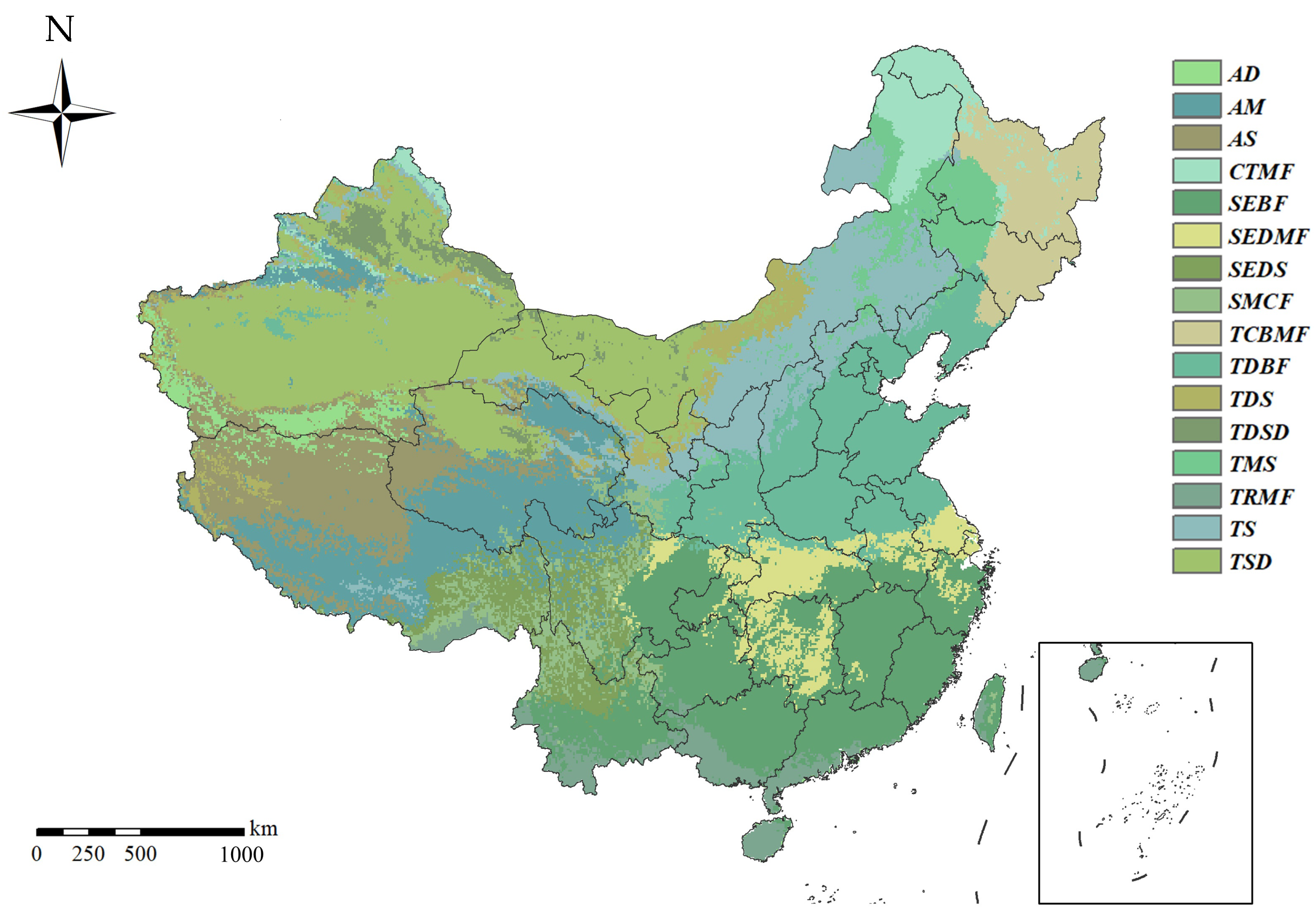



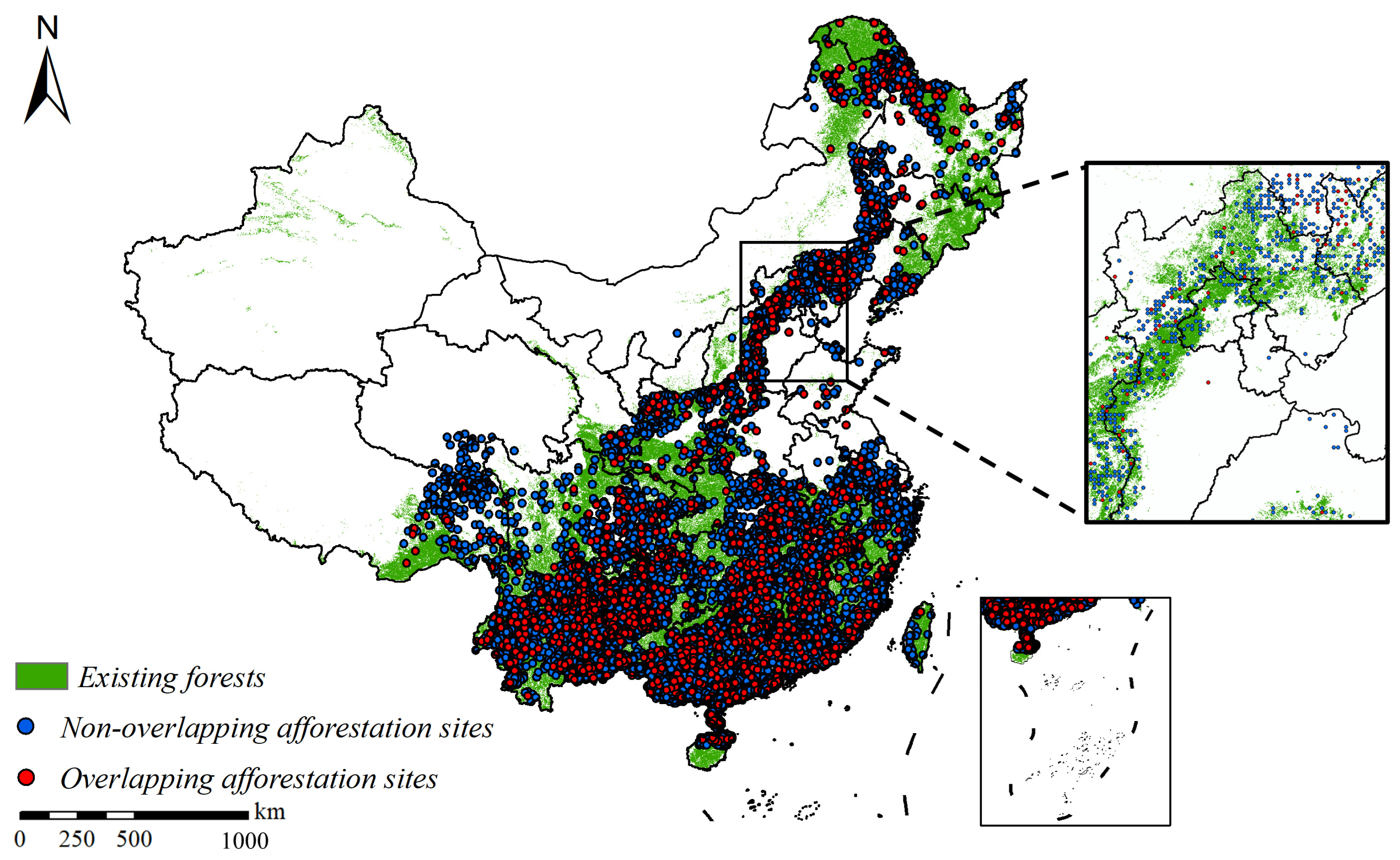
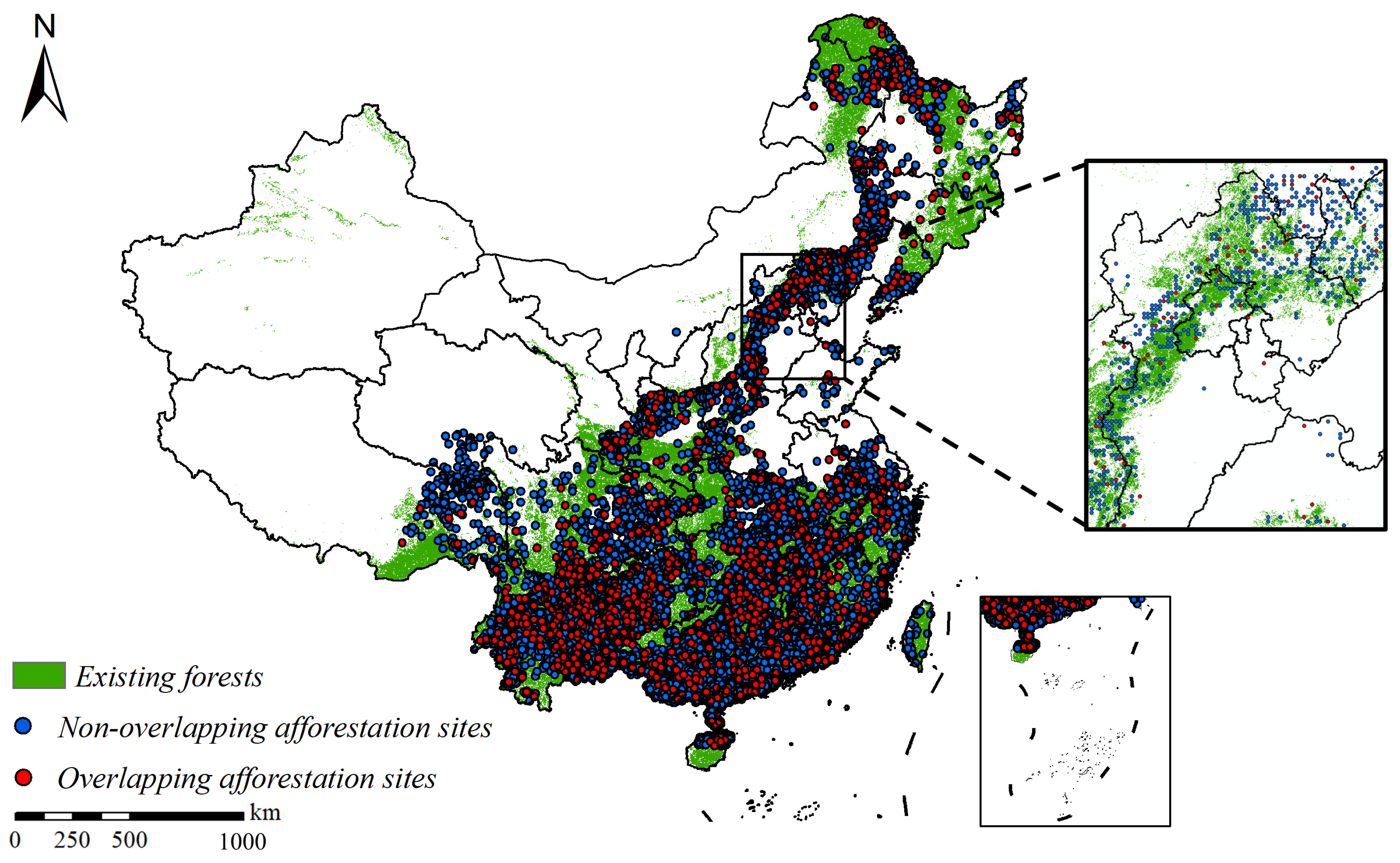
| Value | Vegetation Classification | Vegetation Type |
|---|---|---|
| 1 | desert | Alpine desert (AD) |
| 2 | grassland | Alpine meadow (AM) |
| 3 | grassland | Alpine steppe (AS) |
| 4 | forest | Cold-temperate and temperate mountainous coniferous forest (CTMF) |
| 5 | forest | Subtropical evergreen–broadleaf forest (SEBF) |
| 6 | forest | Subtropical evergreen and deciduous broadleaf mixed forest (SEDMF) |
| 7 | shrubland | Subalpine evergreen and deciduous shrub (SEDS) |
| 8 | forest | Subtropical mountainous cool coniferous forest (SMCF) |
| 9 | forest | Temperate coniferous–broadleaf mixed forest (TCBMF) |
| 10 | forest | Temperate deciduous–broadleaf forest (TDBF) |
| 11 | grassland | Temperate desert steppe (TDS) |
| 12 | desert | Temperate dwarf semi-arboreous desert (TDSD) |
| 13 | grassland | Temperate meadow steppe (TMS) |
| 14 | forest | Tropical rainforest and monsoon forest (TRMF) |
| 15 | grassland | Temperate typical steppe (TS) |
| 16 | desert | Temperate shrub desert and dwarf semi-shrub desert (TSD) |
| Value | Vegetation Shift | Level |
|---|---|---|
| 1 | unchanged forest type | 5 |
| 2 | conversion between forest types | 4 |
| 3 | forest to grassland | 3 |
| 4 | grassland to forest | 5 |
| 5 | unchanged grassland type | 3 |
| 6 | grassland to desert | 1 |
| 7 | unchanged desert type | 1 |
| 8 | forest to desert | 1 |
| 9 | desert to grassland | 2 |
| 10 | desert to forest | 5 |
| 11 | grassland to shrubland | 4 |
| 12 | shrubland to grassland | 3 |
| 13 | unchanged shrubland type | 5 |
| 14 | shrubland to desert | 1 |
| 15 | shrubland to forest | 5 |
| 16 | forest to shrubland | 5 |
| Period | Ecological and Geographical Divisions | Area (km²) | Period | Ecological and Geographical Divisions | Area (km²) |
|---|---|---|---|---|---|
| 2021–2025 | humid | 632,896 | 2041–2045 | humid | 645,184 |
| humid semi-humid | 102,272 | humid semi-humid | 108,928 | ||
| semi-humid | 6912 | semi-humid | 22,976 | ||
| semi-arid | 1152 | semi-arid | 1024 | ||
| arid | 320 | arid | 192 | ||
| 2026–2030 | humid | 660,672 | 2046–2050 | humid | 641,920 |
| humid semi-humid | 88,512 | humid semi-humid | 63,744 | ||
| semi-humid | 9600 | semi-humid | 8320 | ||
| semi-arid | 960 | semi-arid | 832 | ||
| arid | 192 | arid | 192 | ||
| 2031–2035 | humid | 650,688 | 2051–2055 | humid | 637,376 |
| humid semi-humid | 121,984 | humid semi-humid | 81,792 | ||
| semi-humid | 7744 | semi-humid | 14,656 | ||
| semi-arid | 6016 | semi-arid | 1024 | ||
| arid | 192 | arid | 192 | ||
| 2036–2040 | humid | 653,440 | 2056–2060 | humid | 645,120 |
| humid semi-humid | 75,712 | humid semi-humid | 80,768 | ||
| semi-humid | 8512 | semi-humid | 8640 | ||
| semi-arid | 1024 | semi-arid | 1088 | ||
| arid | 192 | arid | 256 |
| Datasets | Total Overlap Points | Average Overlap Points Per Year | Total Non-Overlap Points | Average Non-Overlap Points Per Year |
|---|---|---|---|---|
| Forest cover dataset [32] | 2110 | 53 | 9090 | 227 |
| GlobeLand30 dataset [30] | 1568 | 39 | 9632 | 241 |
| GLC_FCS30 dataset [31] | 1482 | 37 | 9718 | 243 |
References
- Pan, Y.; Birdsey, R.A.; Fang, J.; Houghton, R.; Kauppi, P.E.; Kurz, W.A.; Phillips, O.L.; Shvidenko, A.; Lewis, S.L.; Canadell, J.G.; et al. A Large and Persistent Carbon Sink in the World’s Forests. Science 2011, 333, 988–993. [Google Scholar] [CrossRef]
- Chen, B.; Chen, F.; Ciais, P.; Zhang, H.; Lü, H.; Wang, T.; Chevallier, F.; Liu, Z.; Yuan, W.; Peters, W. Challenges to Achieve Carbon Neutrality of China by 2060: Status and Perspectives. Sci. Bull. 2022, 67, 2030–2035. [Google Scholar] [CrossRef]
- He, J.; Li, Z.; Zhang, X.; Wang, H.; Dong, W.; Chang, S.; Ou, X.; Guo, S.; Tian, Z.; Gu, A.; et al. Comprehensive Report on China’s Long-Term Low-Carbon Development Strategies and Pathways. Chin. J. Popul. Resour. Environ. 2020, 18, 263–295. [Google Scholar] [CrossRef]
- Meinshausen, M.; Lewis, J.; McGlade, C.; Gütschow, J.; Nicholls, Z.; Burdon, R.; Cozzi, L.; Hackmann, B. Realization of Paris Agreement Pledges May Limit Warming Just below 2 °C. Nature 2022, 604, 304–309. [Google Scholar] [CrossRef] [PubMed]
- Mo, L.; Zohner, C.M.; Reich, P.B.; Liang, J.; de Miguel, S.; Nabuurs, G.-J.; Renner, S.S.; van den Hoogen, J.; Araza, A.; Herold, M.; et al. Integrated Global Assessment of the Natural Forest Carbon Potential. Nature 2023, 624, 92–101. [Google Scholar] [CrossRef]
- Azam, A.; Rafiq, M.; Shafique, M.; Yuan, J. Mitigating Carbon Emissions in China: The Role of Clean Energy, Technological Innovation, and Political-Institutional Quality. Front. Environ. Sci. 2022, 10, 814439. [Google Scholar] [CrossRef]
- Law, B.E.; Harmon, M.E. Forest Sector Carbon Management, Measurement and Verification, and Discussion of Policy Related to Climate Change. Carbon Manag. 2011, 2, 73–84. [Google Scholar] [CrossRef]
- Cheng, K.; Yang, H.; Tao, S.; Su, Y.; Guan, H.; Ren, Y.; Hu, T.; Li, W.; Xu, G.; Chen, M.; et al. Carbon Storage through China’s Planted Forest Expansion. Nat. Commun. 2024, 15, 4106. [Google Scholar] [CrossRef]
- Nave, L.E.; Swanston, C.W.; Mishra, U.; Nadelhoffer, K.J. Afforestation Effects on Soil Carbon Storage in the United States: A Synthesis. Soil Sci. Soc. Am. J. 2013, 77, 1035–1047. [Google Scholar] [CrossRef]
- Tong, X.; Han, X.; Faqi, W.; Zhao, F.; Ren, C.; Li, J. Change in Carbon Storage in Soil Physical Fractions after Afforestation of Former Arable Land. Soil Sci. Soc. Am. J. 2016, 80, 1098–1106. [Google Scholar] [CrossRef]
- Lu, F.; Hu, H.; Sun, W.; Zhu, J.; Liu, G.; Zhou, W.; Zhang, Q.; Shi, P.; Liu, X.; Wu, X.; et al. Effects of National Ecological Restoration Projects on Carbon Sequestration in China from 2001 to 2010. Proc. Natl. Acad. Sci. USA 2018, 115, 4039–4044. [Google Scholar] [CrossRef] [PubMed]
- Piao, S.; Yue, C.; Ding, J.; Guo, Z. Perspectives on the Role of Terrestrial Ecosystems in the ‘Carbon Neutrality’ Strategy. Sci. China Earth Sci. 2022, 65, 1178–1186. [Google Scholar] [CrossRef]
- Yu, Z.; Ciais, P.; Piao, S.; Houghton, R.A.; Lu, C.; Tian, H.; Agathokleous, E.; Kattel, G.R.; Sitch, S.; Goll, D.; et al. Forest Expansion Dominates China’s Land Carbon Sink since 1980. Nat. Commun. 2022, 13, 5374. [Google Scholar] [CrossRef]
- National Development and Reform Commission; Ministry of Natural Resources of China. The Master Plan for Major Projects of National Important Ecosystem Protection and Restoration (2021–2035); National Development and Reform Commission and Ministry of Natural Resources of China: Beijing, China, 2020; pp. 10–11. [Google Scholar]
- Lü, D.; Lü, Y.; Gao, G.; Sun, S.; Wang, Y.; Fu, B. A Landscape Persistence-Based Methodological Framework for Assessing Ecological Stability. Environ. Sci. Ecotechnol. 2024, 17, 100300. [Google Scholar] [CrossRef]
- Tappeiner, U.; Leitinger, G.; Zariņa, A.; Bürgi, M. How to Consider History in Landscape Ecology: Patterns, Processes, and Pathways. Landsc. Ecol. 2021, 36, 2317–2328. [Google Scholar] [CrossRef]
- Tian, L.; Zhang, B.; Wang, X.; Chen, S.; Pan, B. Large-Scale Afforestation Over the Loess Plateau in China Contributes to the Local Warming Trend. Geophys. Res. Atmos. 2022, 127, e2021JD035730. [Google Scholar] [CrossRef]
- Xu, J. Estimation of the Spatial Distribution of Potential Forestation Land and Its Climatic Potential Productivity in China. ACTA Geogr. Sin. 2023, 78, 677. [Google Scholar] [CrossRef]
- World Resources Institute Data from “Atlas of Forest and Landscape Restoration Opportunities” 2021. Available online: https://www.wri.org/data/atlas-forest-and-landscape-restoration-opportunities (accessed on 28 May 2024).
- Bastin, J.-F.; Finegold, Y.; Garcia, C.; Mollicone, D.; Rezende, M.; Routh, D.; Zohner, C.M.; Crowther, T.W. The Global Tree Restoration Potential. Science 2019, 365, 76–79. [Google Scholar] [CrossRef] [PubMed]
- Baudena, M.; Dekker, S.C.; Van Bodegom, P.M.; Cuesta, B.; Higgins, S.I.; Lehsten, V.; Reick, C.H.; Rietkerk, M.; Scheiter, S.; Yin, Z.; et al. Forests, Savannas, and Grasslands: Bridging the Knowledge Gap between Ecology and Dynamic Global Vegetation Models. Biogeosciences 2015, 12, 1833–1848. [Google Scholar] [CrossRef]
- Xu, H.; Yue, C.; Zhang, Y.; Liu, D.; Piao, S. Forestation at the Right Time with the Right Species Can Generate Persistent Carbon Benefits in China. Proc. Natl. Acad. Sci. USA 2023, 120, e2304988120. [Google Scholar] [CrossRef]
- Batunacun; Wieland, R.; Lakes, T.; Hu, Y.; Nendel, C. Identifying Drivers of Land Degradation in Xilingol, China, between 1975 and 2015. Land Use Policy 2019, 83, 543–559. [Google Scholar] [CrossRef]
- Liu, Y.; Wang, L.; Long, H. Spatio-Temporal Analysis of Land-Use Conversion in the Eastern Coastal China during 1996–2005. J. Geogr. Sci. 2008, 18, 274–282. [Google Scholar] [CrossRef]
- Lyu, R.; Zhang, J.; Xu, M.; Li, J. Impacts of Urbanization on Ecosystem Services and Their Temporal Relations: A Case Study in Northern Ningxia, China. Land Use Policy 2018, 77, 163–173. [Google Scholar] [CrossRef]
- Xing, L.; Xue, M.; Hu, M. Dynamic Simulation and Assessment of the Coupling Coordination Degree of the Economy–Resource–Environment System: Case of Wuhan City in China. J. Environ. Manag. 2019, 230, 474–487. [Google Scholar] [CrossRef]
- Cai, W.; He, N.; Li, M.; Xu, L.; Wang, L.; Zhu, J.; Zeng, N.; Yan, P.; Si, G.; Zhang, X.; et al. Carbon Sequestration of Chinese Forests from 2010 to 2060: Spatiotemporal Dynamics and Its Regulatory Strategies. Sci. Bull. 2022, 67, 836–843. [Google Scholar] [CrossRef]
- Lucas, M.P.; Longman, R.J.; Giambelluca, T.W.; Frazier, A.G.; Mclean, J.; Cleveland, S.B.; Huang, Y.-F.; Lee, J. Optimizing Automated Kriging to Improve Spatial Interpolation of Monthly Rainfall over Complex Terrain. J. Hydrometeorol. 2022, 23, 561–572. [Google Scholar] [CrossRef]
- Hou, H. Global IGBP LULC Projection Dataset under Eight SSPs-RCPs 2022. Available online: https://figshare.com/articles/dataset/Global_IGBP_LULC_projection_dataset_under_eight_SSPs-RCPs/20088368 (accessed on 28 May 2024).
- Jun, C.; Ban, Y.; Li, S. Open Access to Earth Land-Cover Map. Nature 2014, 514, 434. [Google Scholar] [CrossRef] [PubMed]
- Zhang, X.; Mingchun, L.; Xidong, C.; Yuan, G.; Shuai, X.; Jun, M. GLC_FCS30: Global Land-Cover Product with Fine Classification System at 30 m Using Time-Series Landsat Imagery. Earth Syst. Sci. Data 2021, 13, 2753–2776. [Google Scholar] [CrossRef]
- Hou, R.; Meng, S.; Pang, Y. High-Precision Chinese Forest Cover Dataset Based on Multi-Source Land Cover Products 2023. Chinese Science Data 2023. Available online: https://www.scidb.cn/en/detail?dataSetId=6adb09e7cda942659d9de9ffcf8bb76e (accessed on 28 May 2024).
- Editorial Board of Vegetation Map of China, Chinese Academy of Sciences (EBVM). 1:1,000,000 Vegetation Distribution Map of China; Science Press: Beijing, China, 2001. [Google Scholar]
- Xu, X.; Zhang, D.; Zhang, Y.; Yao, S.; Zhang, J. Evaluating the Vegetation Restoration Potential Achievement of Ecological Projects: A Case Study of Yan’an, China. Land Use Policy 2020, 90, 104293. [Google Scholar] [CrossRef]
- Zhou, G.; Zheng, Y.; Luo, T.; Chen, S. NPP model of natural vegetation and its application in China. Sci. Silvae Sin. 1998, 34, 2. [Google Scholar]
- Li, Z.; Duan, C.; Jin, L.; Hu, X.; Li, B.; Yang, H. Spatial and Temporal Variability of Climatic Potential Productivity in Yunnan Province, China. Chin. J. Appl. Ecol. 2019, 30, 2181–2190. [Google Scholar] [CrossRef]
- Mann, H.B. Nonparametric Tests against Trend. Econometrica 1945, 13, 245. [Google Scholar] [CrossRef]
- N. L. J. Rank Correlation Methods. By Maurice G. Kendall, M.A. [Pp. Vii + 160. London: Charles Griffin and Co. Ltd., 42 Drury Lane, 1948. 18s.]. J. Inst. Actuar. 1949, 75, 140–141. [Google Scholar] [CrossRef]
- Shadmani, M.; Marofi, S.; Roknian, M. Trend Analysis in Reference Evapotranspiration Using Mann-Kendall and Spearman’s Rho Tests in Arid Regions of Iran. Water Resour. Manag. 2012, 26, 211–224. [Google Scholar] [CrossRef]
- Zhang, L.; Sun, P.; Huettmann, F.; Liu, S. Where Should China Practice Forestry in a Warming World? Glob. Chang. Biol. 2022, 28, 2461–2475. [Google Scholar] [CrossRef]
- Editorial Committee of Vegetation of China (ECVC). Vegetation of China; Science Press: Beijing, China, 1980. [Google Scholar]
- Wu, Z. Chinese Forests; Chinese Forestry Press: Beijing, China, 2001. [Google Scholar]
- Karavani, A.; Boer, M.M.; Baudena, M.; Colinas, C.; Díaz-Sierra, R.; Pemán, J.; de Luis, M.; Enríquez-de-Salamanca, Á.; Resco de Dios, V. Fire-Induced Deforestation in Drought-Prone Mediterranean Forests: Drivers and Unknowns from Leaves to Communities. Ecol. Monogr. 2018, 88, 141–169. [Google Scholar] [CrossRef]
- Liaw, A.; Wiener, M. Classification and Regression by randomForest. R News 2002, 2, 18–22. [Google Scholar]
- Liang, M.; Cao, R.; Di, K.; Han, D.; Hu, Z. Vegetation Resistance and Resilience to a Decade-long Dry Period in the Temperate Grasslands in China. Ecol. Evol. 2021, 11, 10582–10589. [Google Scholar] [CrossRef] [PubMed]
- Forzieri, G.; Dakos, V.; McDowell, N.G.; Ramdane, A.; Cescatti, A. Emerging Signals of Declining Forest Resilience under Climate Change. Nature 2022, 608, 534–539. [Google Scholar] [CrossRef]
- Abis, B.; Brovkin, V. Environmental Conditions for Alternative Tree-Cover States in High Latitudes. Biogeosciences 2017, 14, 511–527. [Google Scholar] [CrossRef]
- Ciemer, C.; Boers, N.; Hirota, M.; Kurths, J.; Müller-Hansen, F.; Oliveira, R.S.; Winkelmann, R. Higher Resilience to Climatic Disturbances in Tropical Vegetation Exposed to More Variable Rainfall. Nat. Geosci. 2019, 12, 174–179. [Google Scholar] [CrossRef]
- Hirota, M.; Holmgren, M.; van Nes, E.H.; Scheffer, M. Global Resilience of Tropical Forest and Savanna to Critical Transitions. Science 2011, 334, 232–235. [Google Scholar] [CrossRef] [PubMed]
- Scheffer, M.; Hirota, M.; Holmgren, M.; Van Nes, E.H.; Chapin, F.S. Thresholds for Boreal Biome Transitions. Proc. Natl. Acad. Sci. USA 2012, 109, 21384–21389. [Google Scholar] [CrossRef] [PubMed]
- Xu, X. Vegetation Cover Resilience Data Set for Countries along the Belt and Road (2000–2020). Natl. Tibet. Plateau Data Cent. 2022. [Google Scholar] [CrossRef]
- Li, X. Using “Random Forest” for Classification and Regression. Chin. Bull. Entomol. 2013, 50, 1190–1197. [Google Scholar]
- Xu, B.; Guo, Z.; Piao, S.; Fang, J. Biomass Carbon Stocks in China’s Forests between 2000 and 2050: A Prediction Based on Forest Biomass-Age Relationships. Sci. China Life Sci. 2010, 53, 776–783. [Google Scholar] [CrossRef]
- Yang, Y.; Luo, Y.; Finzi, A.C. Carbon and Nitrogen Dynamics during Forest Stand Development: A Global Synthesis. New Phytol. 2011, 190, 977–989. [Google Scholar] [CrossRef]
- He, N.; Wen, D.; Zhu, J.; Tang, X.; Xu, L.; Zhang, L.; Hu, H.; Huang, M.; Yu, G. Vegetation Carbon Sequestration in Chinese Forests from 2010 to 2050. Glob. Chang. Biol. 2016, 23, 1575–1584. [Google Scholar] [CrossRef]
- Yu, D.; Wang, X.; Yin, Y.; Zhan, J.; Lewis, B.J.; Tian, J.; Bao, Y.; Zhou, W.; Zhou, L.; Dai, L. Estimates of Forest Biomass Carbon Storage in Liaoning Province of Northeast China: A Review and Assessment. PLoS ONE 2014, 9, e89572. [Google Scholar] [CrossRef]
- Cook, R.L.; Binkley, D.; Mendes, J.C.T.; Stape, J.L. Soil Carbon Stocks and Forest Biomass Following Conversion of Pasture to Broadleaf and Conifer Plantations in Southeastern Brazil. For. Ecol. Manag. 2014, 324, 37–45. [Google Scholar] [CrossRef]
- Li, S.; Huang, X.; Tang, R.; Li, J.; Zhu, B.; Su, J. Soil Microbial Diversity and Network Complexity Sustain Ecosystem Multifunctionality Following Afforestation in a Dry-Hot Valley Savanna. Catena 2023, 231, 107329. [Google Scholar] [CrossRef]
- Liu, H. It Is Difficult for China’s Greening through Large-Scale afforestation to cross the Hu Line. Sci. China Earth Sci. 2019, 62, 1662–1664. [Google Scholar] [CrossRef]
- Smith, T.; Boers, N. Reliability of Vegetation Resilience Estimates Depends on Biomass Density. Nat. Ecol. Evol. 2023, 7, 1799–1808. [Google Scholar] [CrossRef]
- Watson, G. Tree Size Affects Root Regeneration and Top Growth After Transplanting. Arboric. Urban For. 1985, 11, 37–40. [Google Scholar] [CrossRef]
- Li, Y.; Piao, S.; Li, L.Z.X.; Chen, A.; Wang, X.; Ciais, P.; Huang, L.; Lian, X.; Peng, S.; Zeng, Z.; et al. Divergent Hydrological Response to Large-Scale Afforestation and Vegetation Greening in China. Sci. Adv. 2018, 4, eaar4182. [Google Scholar] [CrossRef] [PubMed]
- Peng, S.-S.; Piao, S.; Zeng, Z.; Ciais, P.; Zhou, L.; Li, L.Z.X.; Myneni, R.B.; Yin, Y.; Zeng, H. Afforestation in China Cools Local Land Surface Temperature. Proc. Natl. Acad. Sci. USA 2014, 111, 2915–2919. [Google Scholar] [CrossRef] [PubMed]
- Hua, F.; Bruijnzeel, L.A.; Meli, P.; Martin, P.A.; Zhang, J.; Nakagawa, S.; Miao, X.; Wang, W.; McEvoy, C.; Peña-Arancibia, J.L.; et al. The Biodiversity and Ecosystem Service Contributions and Trade-Offs of Forest Restoration Approaches. Science 2022, 376, 839–844. [Google Scholar] [CrossRef]
- Veldman, J.W.; Overbeck, G.E.; Negreiros, D.; Mahy, G.; Le Stradic, S.; Fernandes, G.W.; Durigan, G.; Buisson, E.; Putz, F.E.; Bond, W.J. Where Tree Planting and Forest Expansion Are Bad for Biodiversity and Ecosystem Services. BioScience 2015, 65, 1011–1018. [Google Scholar] [CrossRef]
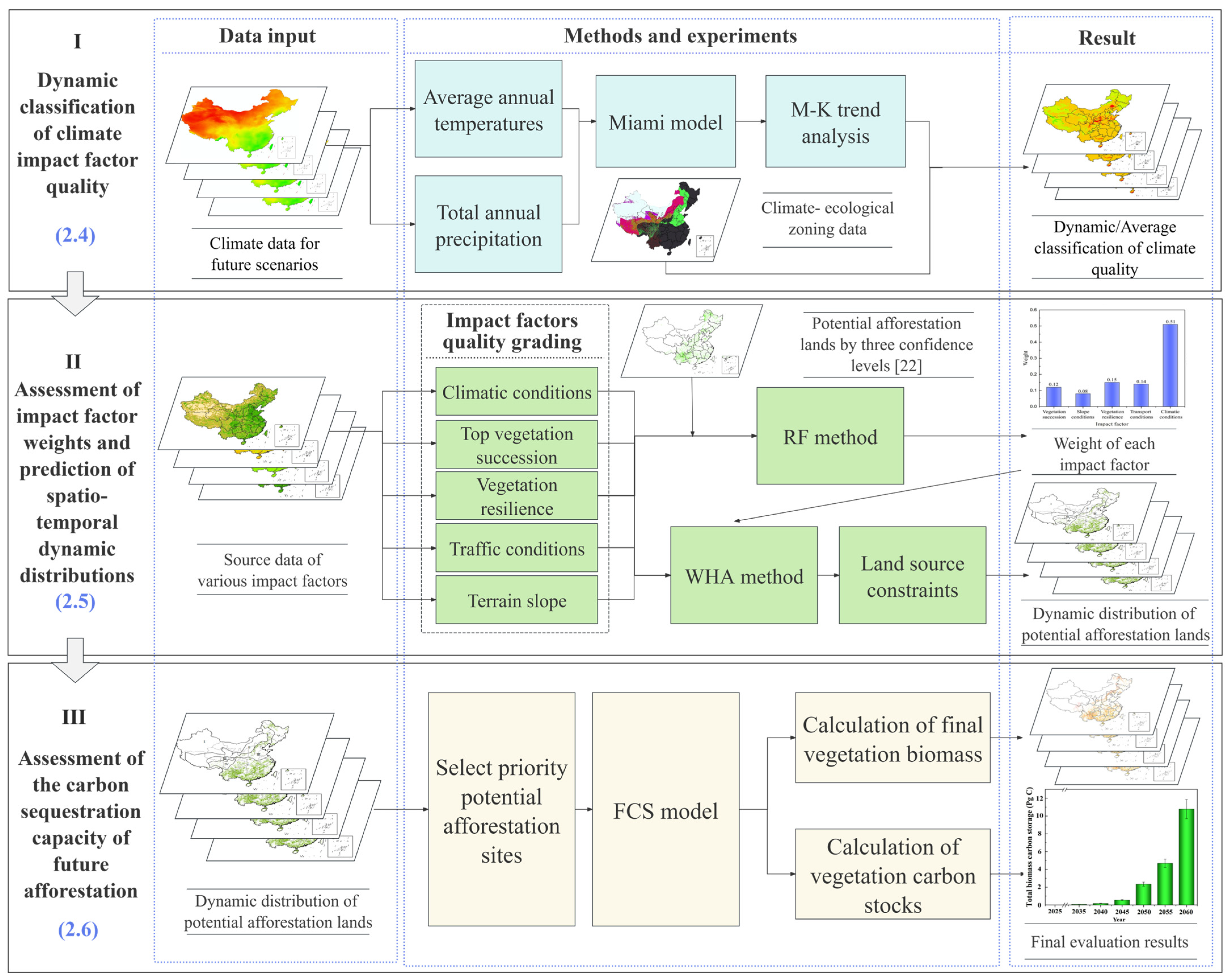

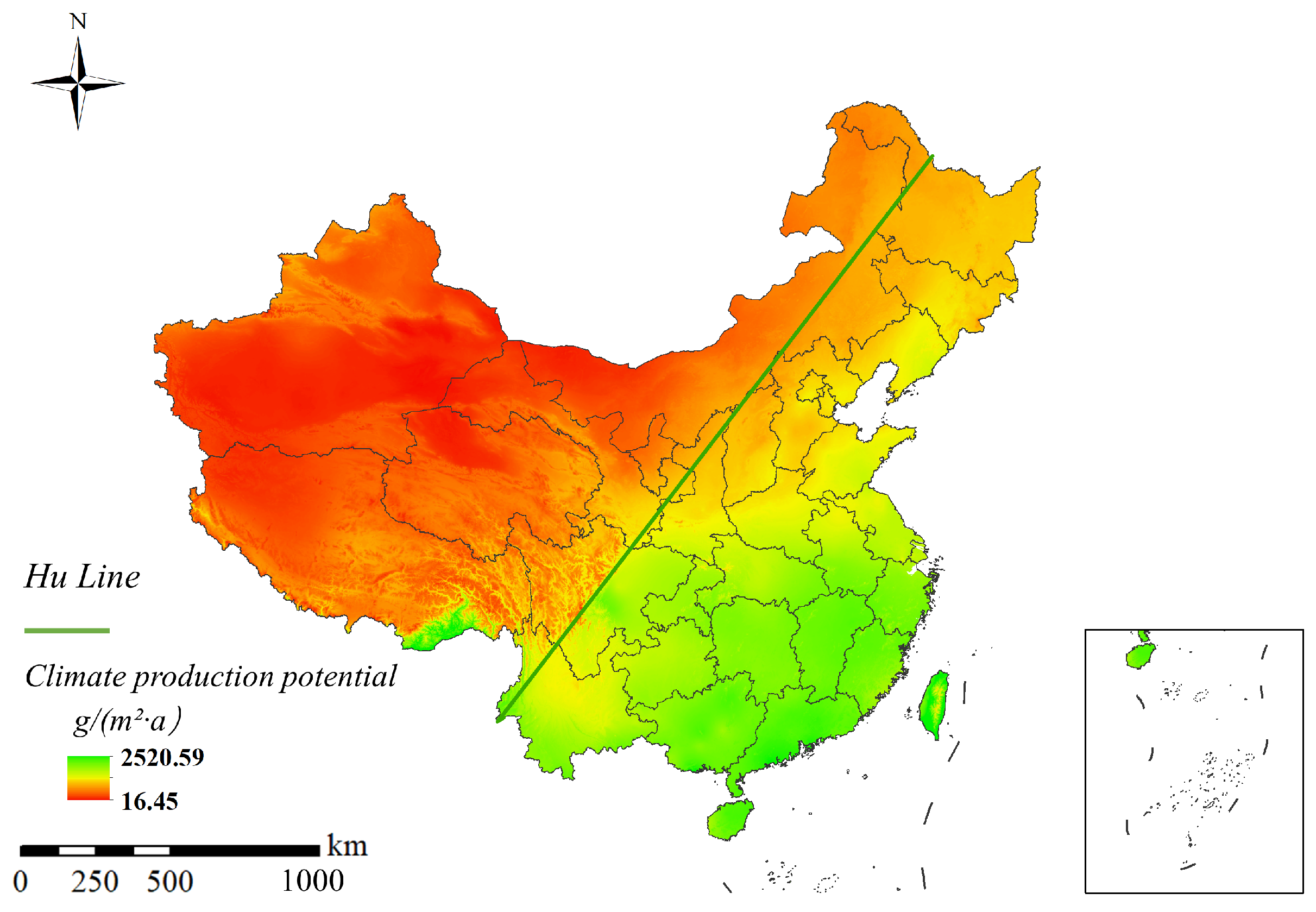
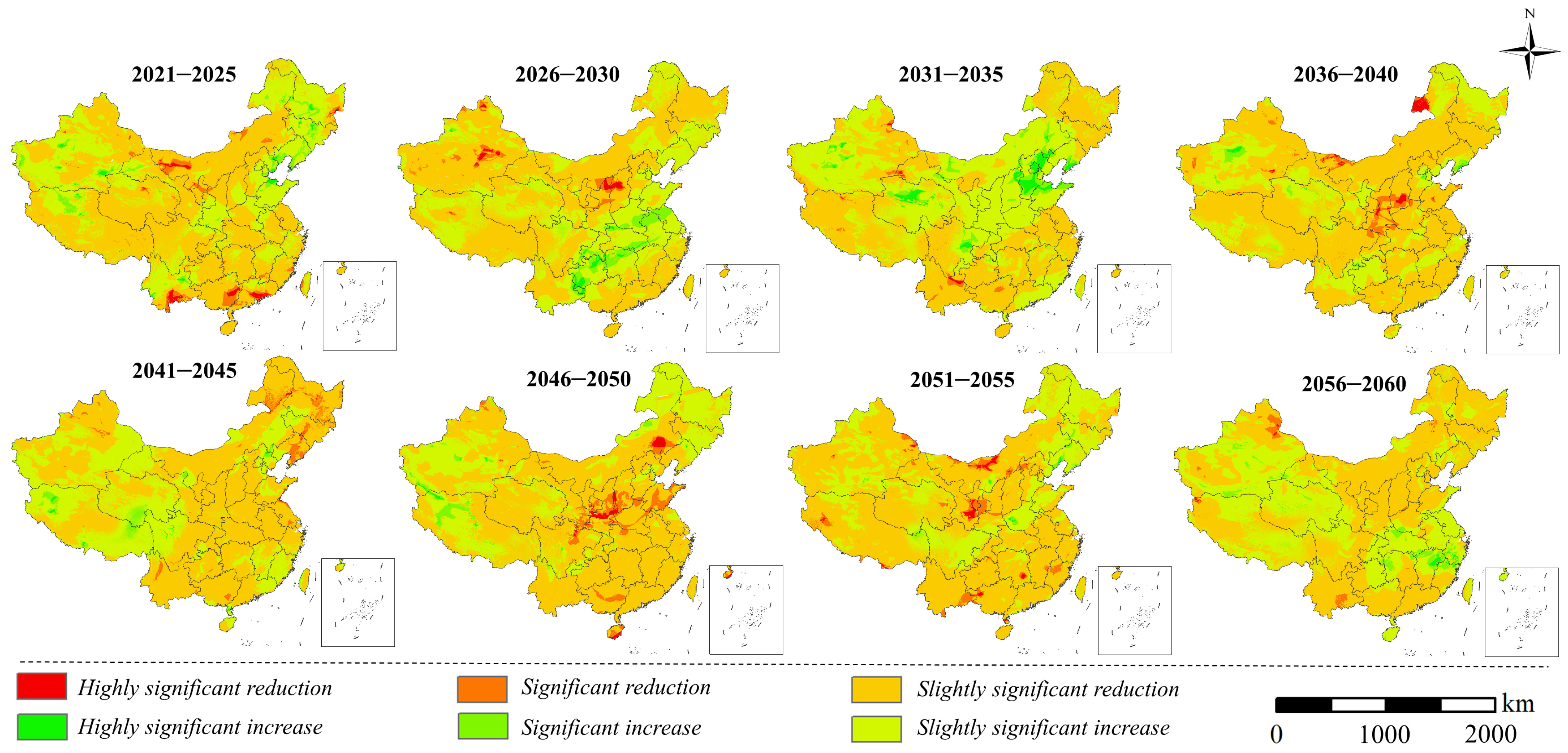

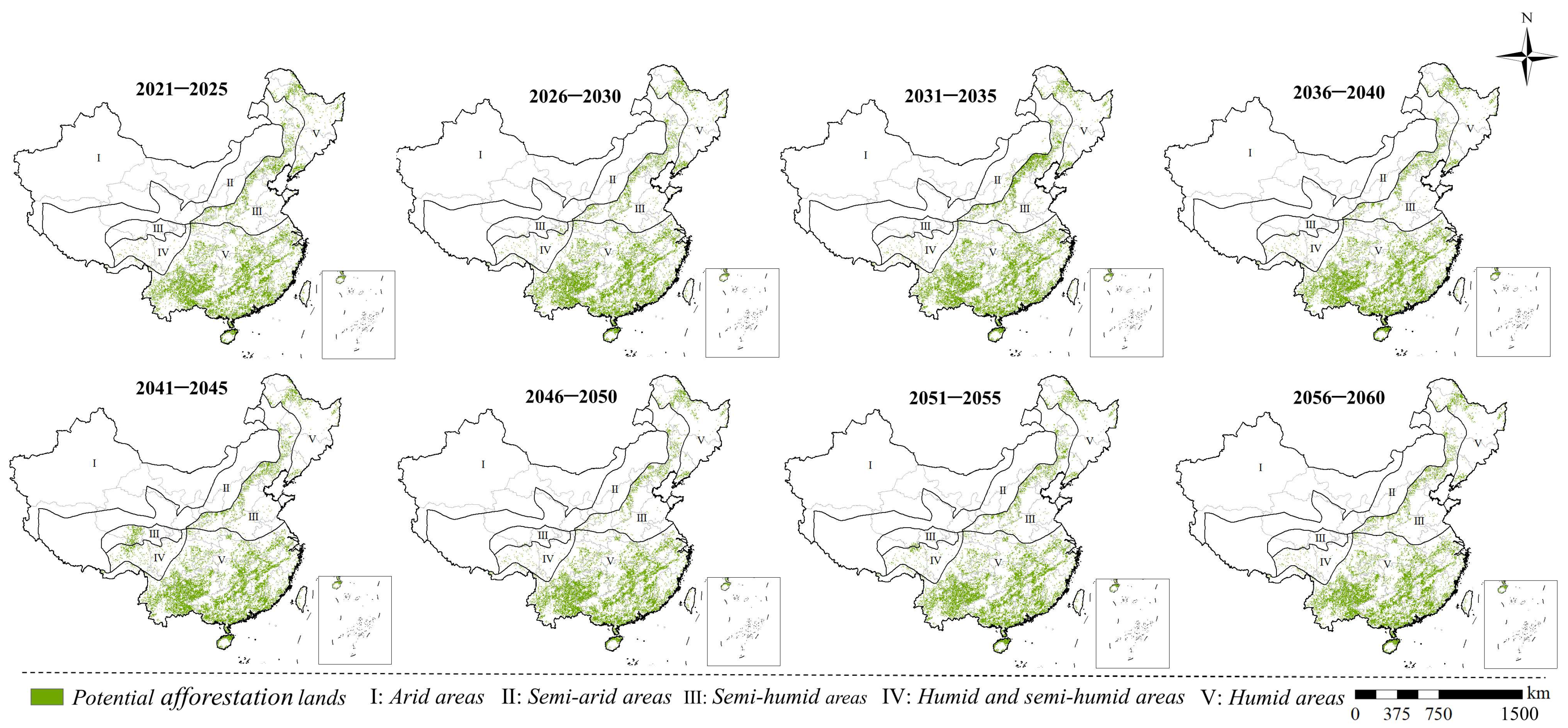
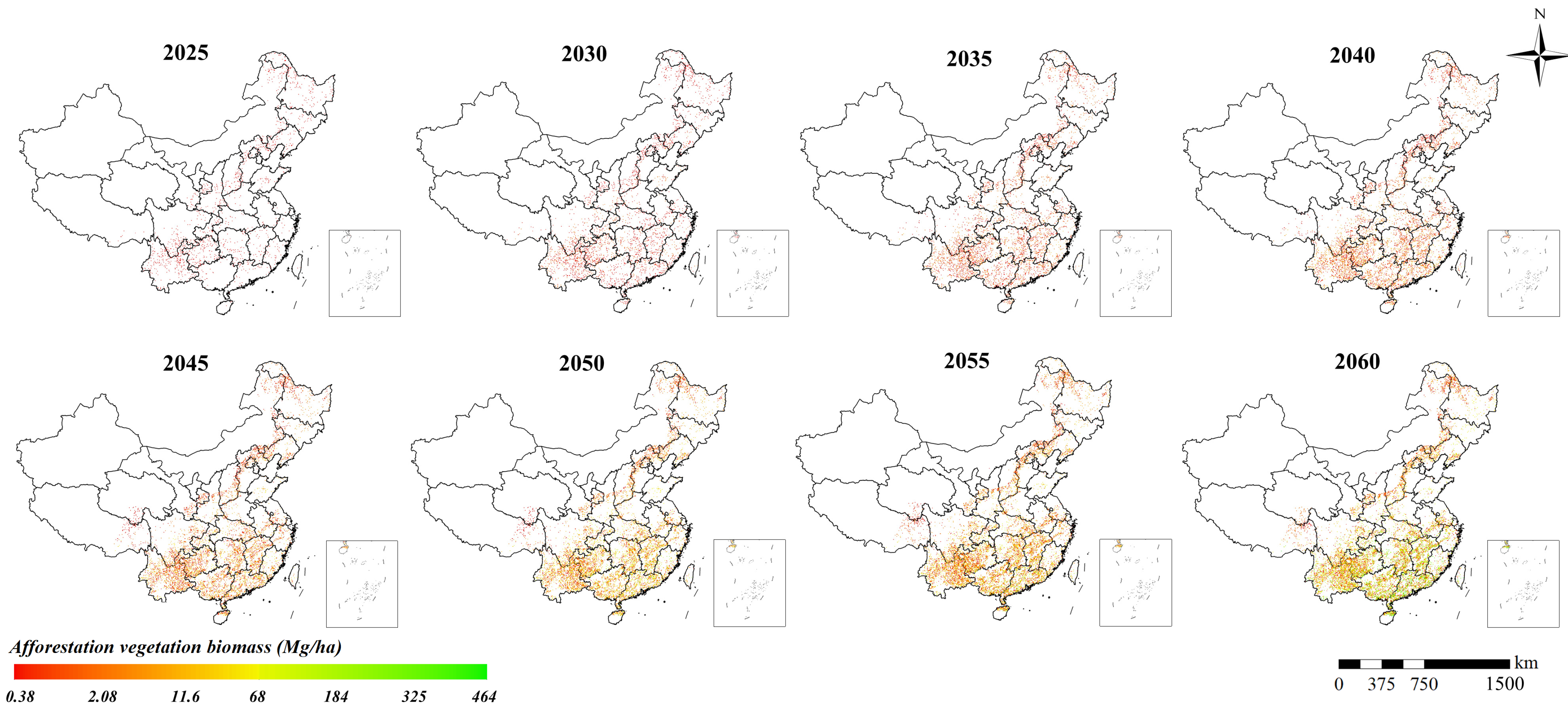


| Data Name | Datasets Source | Year | Format and Resolution | URL |
|---|---|---|---|---|
| LUC data | Global IGBP LULC projection dataset under eight SSPs-RCPs [29] | 2020–2100 | Raster, 1 km | Global IGBP LULC projection dataset under eight SSPs-RCPs (figshare.com) (accessed on 28 April 2024) |
| GlobeLand30; GLC_FCS30 [30,31] | 2020 | Raster, 30 m | http://www.globallandcover.com/ (accessed on 28 April 2024); http://data.casearth.cn (accessed on 16 May 2024) | |
| DEM data | SRTM30 m spatial resolution DEM data | 2000 | Raster, 30 m | https://srtm.csi.cgiar.org/srtmdata/ (accessed on 16 May 2024) |
| Temperature and precipitation data | National Tibetan Plateau Data Center | 2020–2100 | Raster, 1 km | http://data.tpdc.ac.cn/zh-hans/ (accessed on 17 May 2024) |
| Wind direction data | European Center for Medium-Range Weather Forecasts (ECMWF) | 1950–2024 | Raster, 0.1° | https://www.ecmwf.int/en/forecasts/datasets/reanalysis-datasets/era5 (accessed on 17 May 2024) |
| Ecological zoning data | Eco-geographic partitions in China | 2016 | Vector | http://www.geodata.cn (accessed on 17 May 2024) |
| Treeline data | Derived from temperature data [18] | 1991–2020 | Raster, 30 m | https://doi.org/10.11821/dlxb202303011 (accessed on 17 May 2024) |
| Traffic data | OpenStreetMap Planet | 2017 | Vector | https://planet.openstreetmap.org/ (accessed on 18 May 2024) |
| Vegetation cover resilience data | Vegetation resilience data set for countries along the Belt and Road (2000–2020) | 2000–2020 | Raster, 1 km | https://data.tpdc.ac.cn/zh-hans/data/24312c5e-9288-450b-acba-d5cb9edaea5f/ (accessed on 28 May 2024) |
| Forest cover data | High-precision Forest cover dataset by province in China (2020) [32] | 2020 | Raster, 30 m | https://doi.org/10.57760/sciencedb.09217 (accessed on 17 April 2024) |
| Vegetation map | Vegetation Map of the People’s Republic of China (1:1,000,000) [33] | 1980–1990 | Raster, 10 km | – |
| Baseline climate data | WorldClim database | 1970–2000 | Raster, 8 km | http://www.worldclim.org/ (accessed on 20 May 2024) |
| Province/Autonomous Region | Potential Afforestation Land Area (km²) | ||||||||
|---|---|---|---|---|---|---|---|---|---|
| 2021–2025 | 2026–2030 | 2031–2035 | 2036–2040 | 2041–2045 | 2046–2050 | 2051–2055 | 2056–2060 | Average | |
| Beijing | 3008 | 3072 | 4992 | 3008 | 2752 | 2816 | 2752 | 2752 | 3144 |
| Tianjin | 448 | 192 | 320 | 192 | 192 | 128 | 128 | 128 | 216 |
| Hebei | 22,912 | 18,816 | 37,184 | 18,368 | 20,672 | 18,304 | 17,984 | 18,624 | 21,608 |
| Shanxi | 17,024 | 16,064 | 22,720 | 8832 | 15,424 | 9792 | 14,400 | 13,888 | 14,768 |
| Inner Mongolia | 28,672 | 25,792 | 33,920 | 25,600 | 27,136 | 22,912 | 27,584 | 26,432 | 27,256 |
| Liaoning | 23,744 | 20,032 | 21,952 | 17,152 | 13,824 | 14,592 | 15,424 | 13,248 | 17,496 |
| Jilin | 5248 | 5184 | 4736 | 4416 | 4800 | 3776 | 3648 | 3584 | 4424 |
| Heilongjiang | 29,824 | 27,968 | 25,664 | 25,088 | 23,552 | 24,192 | 24,128 | 22,912 | 25,416 |
| Shanghai | 832 | 576 | 576 | 576 | 576 | 512 | 448 | 384 | 560 |
| Zhejiang | 15,424 | 14,080 | 13,952 | 13,696 | 13,632 | 13,696 | 13,312 | 13,952 | 13,968 |
| Anhui | 12,928 | 13,120 | 12,480 | 12,096 | 11,968 | 11,712 | 11,520 | 12,160 | 12,248 |
| Fujian | 15,744 | 16,128 | 16,256 | 16,256 | 16,384 | 16,320 | 15,808 | 17,152 | 16,256 |
| Jiangxi | 50,624 | 54,592 | 55,168 | 55,744 | 56,384 | 57,024 | 57,152 | 55,936 | 55,328 |
| Shandong | 3456 | 2944 | 2560 | 1920 | 1664 | 1024 | 1344 | 1472 | 2048 |
| Henan | 7488 | 6976 | 6848 | 5632 | 6208 | 4800 | 6400 | 5440 | 6224 |
| Hubei | 26,688 | 28,096 | 27,904 | 26,944 | 27,136 | 26,880 | 26,432 | 24,704 | 26,848 |
| Hunan | 59,136 | 59,200 | 59,072 | 59,392 | 58,816 | 58,688 | 56,704 | 57,664 | 58,584 |
| Guangdong | 68,736 | 72,448 | 72,832 | 73,408 | 73,600 | 73,472 | 73,728 | 75,328 | 72,944 |
| Guangxi | 70,272 | 78,720 | 76,992 | 80,192 | 80,448 | 76,736 | 81,024 | 82,496 | 78,360 |
| Hainan | 11,456 | 11,968 | 12,224 | 12,608 | 12,672 | 10,240 | 12,672 | 12,672 | 12,064 |
| Chongqing | 10,816 | 11,712 | 10,176 | 10,176 | 9984 | 9920 | 9536 | 9728 | 10,256 |
| Sichuan | 42,688 | 45,824 | 46,272 | 41,152 | 42,816 | 39,360 | 40,448 | 39,744 | 42,288 |
| Guizhou | 65,088 | 67,456 | 66,176 | 66,816 | 66,752 | 67,392 | 66,624 | 67,200 | 66,688 |
| Yunnan | 107,264 | 119,616 | 114,112 | 122,176 | 120,384 | 123,584 | 116,224 | 118,464 | 117,728 |
| Tibet | 7168 | 7680 | 7936 | 8512 | 21,824 | 8512 | 14,848 | 9216 | 10,712 |
| Shaanxi | 9920 | 5760 | 9088 | 6208 | 8960 | 2624 | 8256 | 8704 | 7440 |
| Gansu | 11,904 | 11,264 | 11,008 | 9984 | 10,560 | 4800 | 4992 | 10,624 | 9392 |
| Qinghai | 448 | 512 | 640 | 512 | 18,112 | 512 | 2048 | 512 | 2912 |
| Ningxia | 448 | 512 | 512 | 512 | 512 | 128 | 0 | 512 | 392 |
| Hong Kong | 64 | 192 | 192 | 192 | 192 | 192 | 192 | 128 | 168 |
| Jiangsu | 12,544 | 12,352 | 11,008 | 10,304 | 9216 | 9152 | 8192 | 8512 | 10,160 |
| Taiwan | 2240 | 1984 | 2112 | 2112 | 2048 | 2048 | 1856 | 2240 | 2080 |
| Total | 744,256 | 760,832 | 787,584 | 739,776 | 779,200 | 715,840 | 735,808 | 736,512 | 749,976 |
| Province/Autonomous Region | Average Vegetation Biomass (Mg/ha) | Total Vegetation Biomass (Pg) | Province/Autonomous Region | Average Vegetation Biomass (Mg/ha) | Total Vegetation Biomass (Pg) |
|---|---|---|---|---|---|
| Beijing | 5.934 | 0.002 | Hunan | 61.728 | 0.325 |
| Tianjin | 6.000 | - | Guangdong | 100.872 | 0.559 |
| Hebei | 6.372 | 0.013 | Guangxi | 78.749 | 0.454 |
| Shanxi | 9.767 | 0.016 | Hainan | 99.336 | 0.068 |
| Inner Mongolia | 2.653 | 0.008 | Chongqing | 68.792 | 0.072 |
| Liaoning | 15.663 | 0.026 | Sichuan | 39.307 | 0.169 |
| Jilin | 12.185 | 0.006 | Guizhou | 52.51 | 0.335 |
| Heilongjiang | 4.257 | 0.011 | Yunnan | 44.682 | 0.504 |
| Shanghai | 41.400 | 0.003 | Tibet | 7.778 | 0.009 |
| Zhejiang | 52.703 | 0.068 | Shaanxi | 22.020 | 0.214 |
| Anhui | 51.135 | 0.058 | Gansu | 6.646 | 0.007 |
| Fujian | 85.665 | 0.141 | Qinghai | 0.268 | - |
| Jiangxi | 70.941 | 0.359 | Ningxia | 0.250 | - |
| Shandong | 49.604 | 0.019 | Hong Kong | 12.333 | 0.002 |
| Henan | 27.019 | 0.019 | Jiangsu | 32.584 | 0.028 |
| Hubei | 50.638 | 0.131 | Taiwan | 104.406 | 0.021 |
| Related Research | Area of Potential Afforestation Lands | The Area Involved in Carbon Assessment | Carbon Storage in New Forests by 2060 |
|---|---|---|---|
| this study | 7.50 | 7.20 | 11.48 |
| [22] | 7.80 | 7.20 | 10.00 |
| [27] | 7.90 | 2.94 | 1.14 |
| [18] | 6.66 | - | - |
Disclaimer/Publisher’s Note: The statements, opinions and data contained in all publications are solely those of the individual author(s) and contributor(s) and not of MDPI and/or the editor(s). MDPI and/or the editor(s) disclaim responsibility for any injury to people or property resulting from any ideas, methods, instructions or products referred to in the content. |
© 2024 by the authors. Licensee MDPI, Basel, Switzerland. This article is an open access article distributed under the terms and conditions of the Creative Commons Attribution (CC BY) license (https://creativecommons.org/licenses/by/4.0/).
Share and Cite
Zhang, Z.; Wang, Z.; Zhang, X.; Yang, S. Estimation of Spatial–Temporal Dynamic Evolution of Potential Afforestation Land and Its Carbon Sequestration Capacity in China. Remote Sens. 2024, 16, 3098. https://doi.org/10.3390/rs16163098
Zhang Z, Wang Z, Zhang X, Yang S. Estimation of Spatial–Temporal Dynamic Evolution of Potential Afforestation Land and Its Carbon Sequestration Capacity in China. Remote Sensing. 2024; 16(16):3098. https://doi.org/10.3390/rs16163098
Chicago/Turabian StyleZhang, Zhipeng, Zong Wang, Xiaoyuan Zhang, and Shijie Yang. 2024. "Estimation of Spatial–Temporal Dynamic Evolution of Potential Afforestation Land and Its Carbon Sequestration Capacity in China" Remote Sensing 16, no. 16: 3098. https://doi.org/10.3390/rs16163098
APA StyleZhang, Z., Wang, Z., Zhang, X., & Yang, S. (2024). Estimation of Spatial–Temporal Dynamic Evolution of Potential Afforestation Land and Its Carbon Sequestration Capacity in China. Remote Sensing, 16(16), 3098. https://doi.org/10.3390/rs16163098






